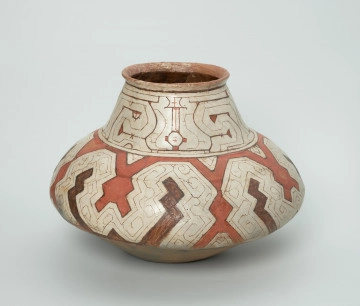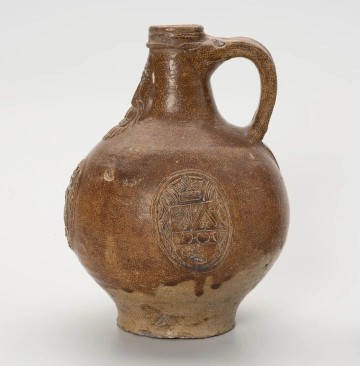
Vessel for storing water and masato
około 1951 — 2000
National Museum in Szczecin
Part of the collection: Crafts of the Amazon Indians
The presented vessel is a traditional product of the Shipibo Indians from Peru. It comes from the collection of Anna Kowalska-Lewicka, an ethnologist and Americanist who, in the late 1940s, researched the Shipibo Indians. The bowl was used to serve masato, beer made from cassava tubers. It also served as a lid for large chomo vessels that held water and beer. Shipibo pottery is made without the use of a potter's wheel. They can be divided into unpainted pots for cooking and painted dishes for storing and serving food. The painted vessels, which include this bowl, are not intended for cooking over fire. After being kneaded, their surfaces are carefully smoothed and then covered with paint, also smoothed, which forms the background for the painted ornament after the vessel has dried. The vessels thus prepared are fired and in the final stage covered with resin, which guarantees impermeability. Masato eating vessels are usually painted with white clay, then covered with rich and colourful ornaments. The presented bowl is decorated with a linear quene composition in rows of delicate wavy lines and zigzags. Indians (both men and women) consume masato during festivals. Intoxication during such events is not considered indecent. Masato is drawn with a calabash from a chomo vessel and filled into bowls. The Shipibo Indians have a uniform, traditionally established artistic style that is evident on most utilitarian objects. The patterns known from their pottery are also found on clothing, kitchen fixtures, house posts and beams, oars, boats and Indian bodies. Decorating is done by both men and women, with men decorating wood and metal products while women decorate clay and cotton. The Shipibo have a fragmentary knowledge of the meaning of the designs used, but they still use them, convinced of their medicinal, spiritual and aesthetic value.
Katarzyna Findlik-Gawron
Author / creator
Dimensions
cały obiekt: height: 9,3 cm, diameter: 23 cm
Object type
bowl
Creation time / dating
Creation / finding place
Identification number
Location / status

około 1951 — 2000
National Museum in Szczecin

1600 — 1699
National Museum in Szczecin

1900 — 1945
National Museum in Szczecin
DISCOVER this TOPIC
Museum of King Jan III's Palace at Wilanów
DISCOVER this PATH
Educational path